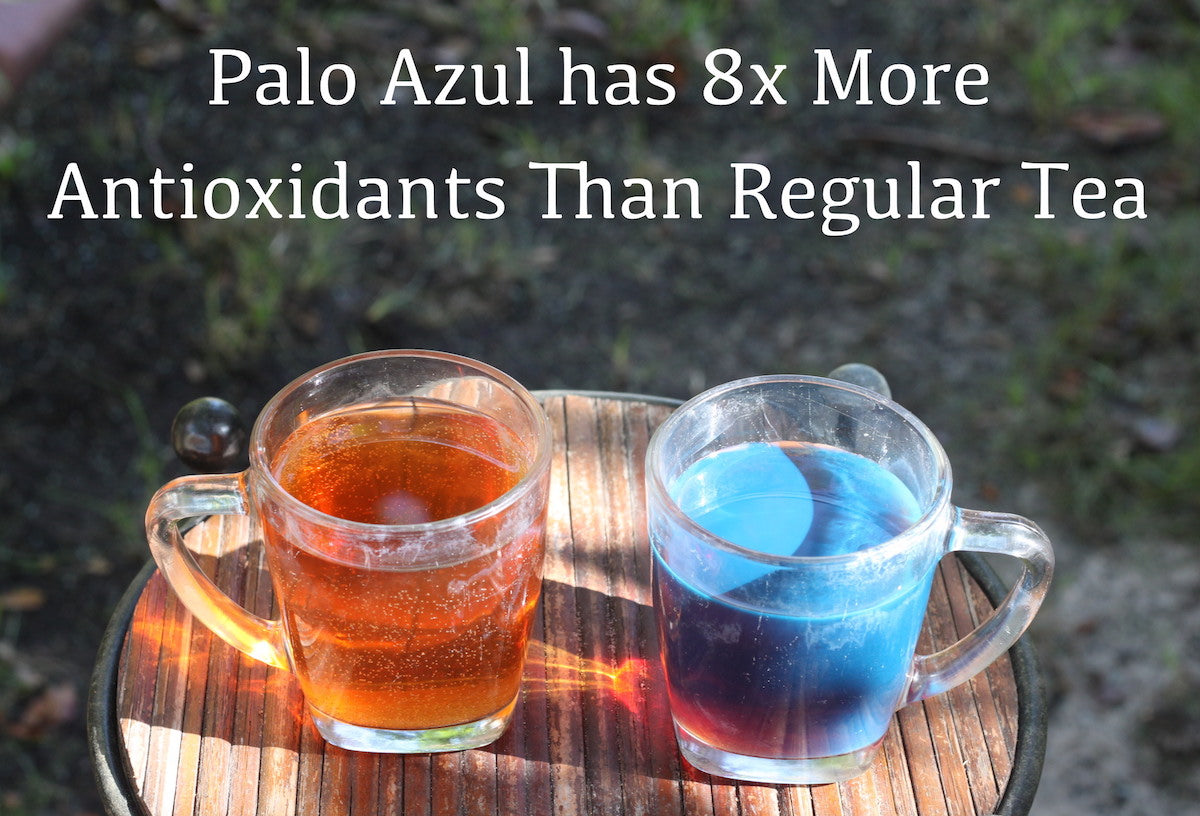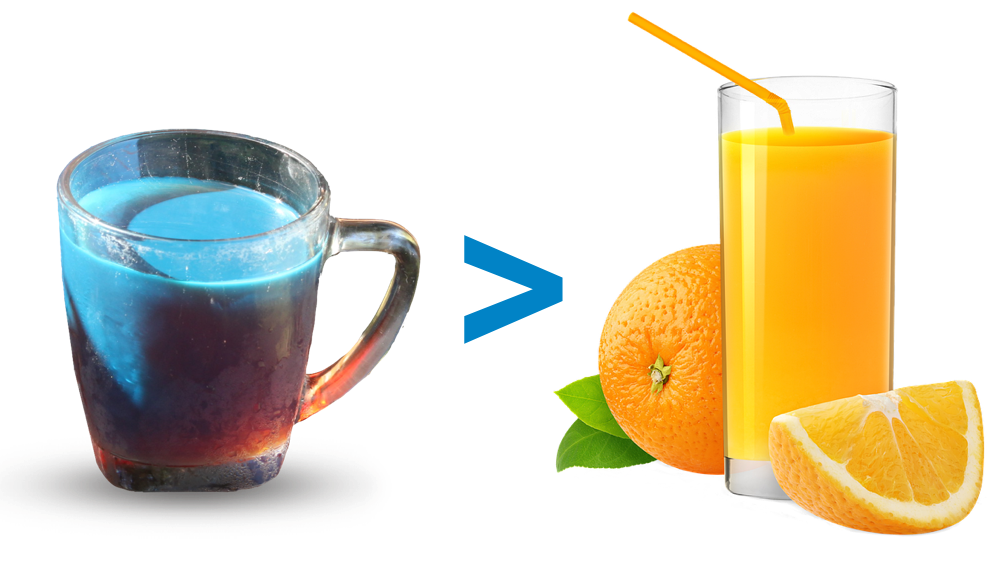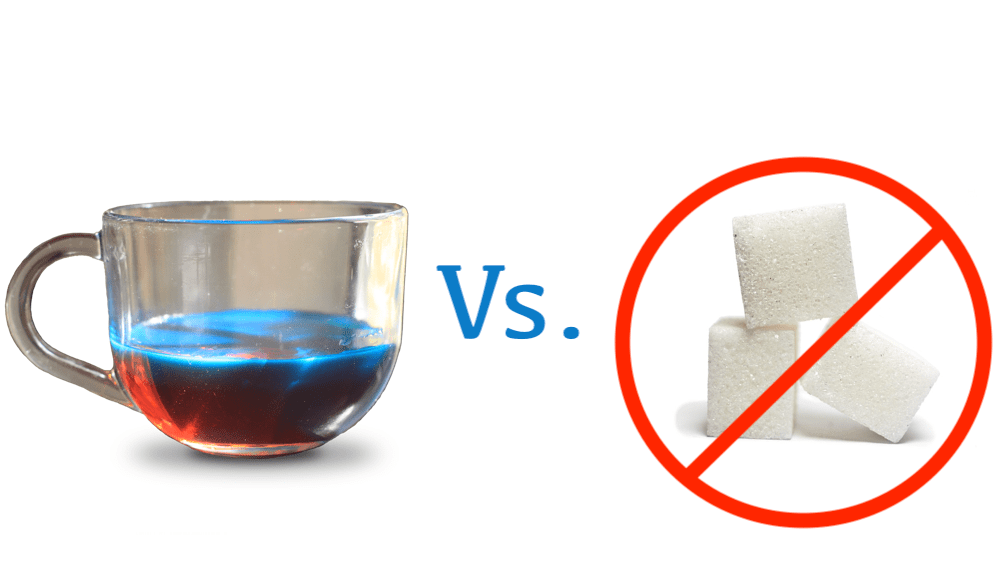Antioxidant
"Palo azul possesses considerable antioxidant activity"
Numerous studies have shown that palo azul tea exhibited significant antioxidant activity due to its polyphenolic/flavonoid rich content. Because of this property, the studies showed that palo azul tea inhibited oxidative stress, free radicals and inhibited the formation of advanced glycation end products (AGEs) and reactive oxygen species (ROS).
For example, this 2022 study concluded that palo azul “significantly reduced oxidative damages in both the kidneys and the liver, and such effect has been related to the high antioxidant capacity."
This 2015 study similarly concluded that the "high antioxidant capacity of (palo azul) may be due to the presence of flavonoids or polyphenols in the extract."
Moreover, this 2007 study showed that "treatment with extracts of (palo azul) displayed a protective effect against AAPH induced damage, indicating a strong antioxidant activity."

Studies Show Palo Azul Has 8x More Antioxidant Capacity Than Regular Tea
1. Scavenge Free Radicals

This 2021 study found that palo azul extracts "rich in phenolic compounds and flavonoids showed high scavenging activities." Therefore, they concluded that palo azul tea "can reduce the oxidative stress caused by the imbalance between reactive oxygen species (ROS) because of its free radical scavenging activity."
Moreover, this 2016 study also showed that palo azul has an ability to reduce oxidative stress under diabetic conditions, prevent and/or delay the onset renal, pancreatic, and hepatic damage through decreasing of lipid peroxidation, antioxidant properties, and increasing radical scavenging enzymes activity, also reduce intracellular reactive oxygen species, and they consequently could alleviate complications of diabetes."
The researchers actually found that "scavenging of hydrogen peroxide by (palo azul) was found to be better compared to the ascorbic acid (Vitamin C)."

This 2014 study similarly showed that "the free radical scavenging activity of (palo azul) showed 98.32% and ascorbic acid 86.53% at the same concentrations." Therefore, the researchers concluded that palo azul extracts were "fast and effective scavengers of the ABTS radical" and that palo azul "is a more efficient scavenger than standard ascorbic acid."
In addition, this 2007 study also showed that treatment with palo azul extracts "displayed both DPPH radical scavenger and antioxidant activities."
This 2018 study showed that palo azul extracts "were effective in scavenging DPPH free radicals in the antioxidant assay for at least 70 h."
2. Inhibit Oxidative Stress

This 2014 study, concluded that “(palo azul) prevents oxidative stress, acts as a suppressor of liver, kidney and pancreas cell damage.”
Moreover, a 2021 study showed that "C. genistoides (palo azul) protects cells against OS (oxidative stress) via the modulation of cellular antioxidant defenses."
This 2016 study found that treatment with palo azul's flavonoids "significantly decreased ROS production preventing oxidative stress." The researchers concluded the following:
"Our data indicates that the bark of Eysenhardtia polystachya (palo azul) has an ability to reduce oxidative stress through decreasing of lipid peroxidation, antioxidant properties, and increasing radical scavenging enzymes activity, also reduce intracellular reactive oxygen species."

Reactive oxygen species are a type of unstable molecule that contains oxygen and that easily reacts with other molecules in a cell. A build up of reactive oxygen species in cells may cause damage to DNA, RNA, and proteins, and may cause cell death. Reactive oxygen species are free radicals.
This 2021 study also found that palo azul extracts "can reduce the oxidative stress caused by the imbalance between reactive oxygen species (ROS)."
3. Antiglycative & Anti-AGEs

According to the American Heart Association Journal, "advanced glycation end products (AGEs) are proteins or lipids that become glycated after exposure to sugars. AGEs are prevalent in the diabetic vasculature and contribute to the development of atherosclerosis."
This 2019 study found that one of palo azul's flavonoids is a "powerful antiglycation compound."
A 2018 study found that palo azul "showed an ability to reduce the formation of advanced glycation end products, and an antioxidant capacity."
This 2014 study which supports to previous studies, found that "(palo azul) possesses considerable antioxidant activity with reactive oxygen species (ROS) scavenging activity and demonstrated an anti-AGEs (advanced glycation end products) and hepatoprotective role, inhibits hyperglycemic, hyperlipidemic and oxidative stress."
This 2018 study also showed that palo azul "markedly reduced the formation of AGEs" and "provided a protective effect against glycation."
Another 2018 study similarly showed that the"bark of E. polystachya showed antioxidant potential, hypoglycemic effects, and inhibition of the formation of advanced glycation end products (AGEs)."
This 2020 review on palo azul found that "among the actions determined are its diuretic [13], antidiabetic, antiglycation [14], antioxidant [15], anti-inflammatory [16], and antimicrobial [17] potential."
4. Boosts antioxidant defense

A 2018 study concluded that "treatment with EP/AgNPs (palo azul extracts) increased the activity of anti-stress biomarkers such as superoxide dismutase (SOD), catalase (CAT), glutathione peroxidase (GPx)." They also mention that palo azul "restored the enzymatic antioxidant system that was able to reduce ROS production." Therefore, the researchers concluded that palo azul can "provide an effective defense against oxidative stress."
A 2007 study similarly found that palo azul "significantly increased the activities of glutathione peroxidase (GSHPx) and catalase (CAT)."
Another 2016 study found that "increases in radical scavenging enzymes of CSH-Px, SOD, GSH, and CAT have also been observed in liver, pancreas, and kidney" in animals treated with palo azul.
This 1990 study explains that "glutathione peroxidase (GPX), superoxide dismutase (SOD) and catalase are the most important enzymes of the cell antioxidant defense system."
5. Rich in Flavonoids

According to a 2016 review, flavonoids are "a group of natural substances with polyphenolic structures and they're found in fruits, vegetables, grains, bark, roots, stems, flowers, tea and wine. These natural products are well known for their beneficial effects on health."

This 2011 study mentions that palo azul's "flavonoids exhibited strong antioxidant activity."
A 2021 study also suggests that "the polyphenolic compounds present in Eysenhardtia polystachya may protect the insulin-secreting cells from oxidative stress."
Lastly, another 2021 study found several phytonutrients in palo azul such as “flavones, isoflavones, flavanones, phenolic compounds, chalcones and dihydrochalcones” which have been linked to its health benefits, highlighting “diuretic, antiglycation, antioxidant, anti-inflammatory, antimicrobial potential.”

Conclusion
In summary...palo azul tea may help to inhibit oxidative stress, free radicals, AGEs and ROS because it has powerful antioxidant and anti-glycative activities, and this is mainly due to its polyphenolic rich content.
P.S...Don't forget to help your loved ones by sharing palo azul's magic with them!

Clinical Studies
Palo azul is also known as: Eysenhardtia polystachya (E. polystachya, E.P), Cyclolepis genistoides (C. genistoides), kidney wood and palo dulce
(2022) Nephroprotective Plants: A Review on the Use in Pre-Renal and Post-Renal Diseases
(2021) Cyclolepis genistoides aqueous extract as source of neuroprotective agents
(2021) Screening Anti-Inflammatory Effects of Flavanones Solutions
(2020) Phytochemical and Pharmacological Study of the Eysenhardtia Genus

